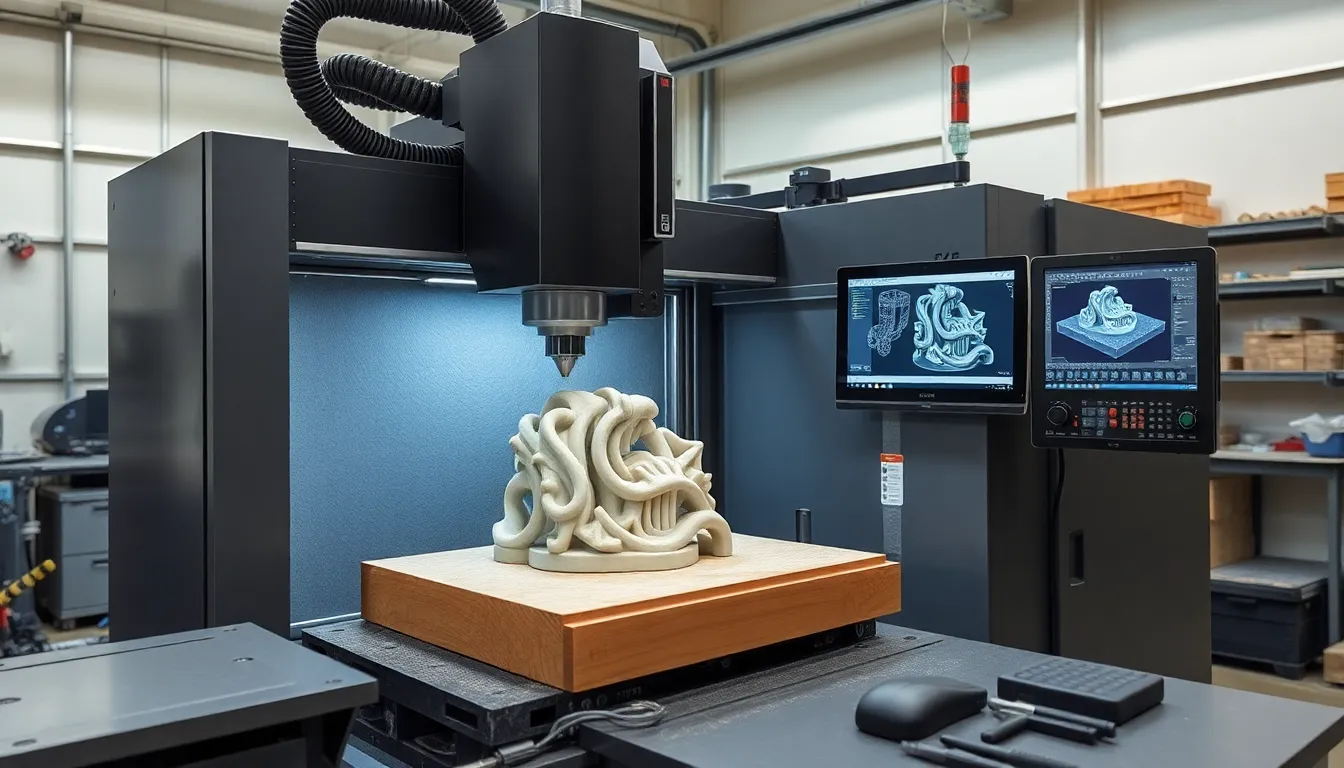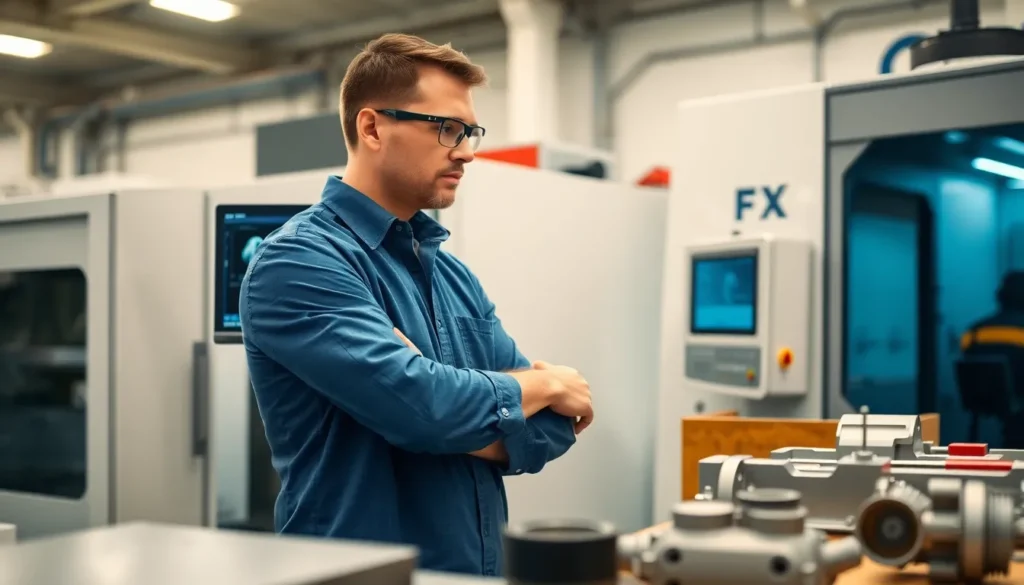In the fast-evolving world of manufacturing, CNC programming software has become an essential tool for precision and efficiency. This software empowers engineers and machinists to create intricate designs and automate machining processes, transforming raw materials into finished products with remarkable accuracy. As industries increasingly adopt automation, understanding the capabilities of CNC programming software is vital for staying competitive.
From simplifying complex tasks to enhancing productivity, CNC programming software offers a range of features that cater to diverse machining needs. With various options available, choosing the right software can significantly impact workflow and output quality. Whether it’s for small workshops or large manufacturing facilities, this technology is reshaping how products are designed and produced, making it a game-changer in the manufacturing landscape.
CNC Programming Software
CNC programming software plays a vital role in modern manufacturing processes. This software streamlines the creation of precise machining instructions from computer-aided design (CAD) drawings. CNC software converts these designs into machine-readable codes, ensuring accurate replication of complex shapes and specifications.
The primary types of CNC programming software include:
- G-Code Generators: These programs translate design files into G-code, a standard language for CNC machines. Users can easily generate G-code for various tasks, enhancing compatibility with different machine types.
- CAM Software: Computer-Aided Manufacturing (CAM) software integrates with CAD applications to automate manufacturing processes. It allows users to simulate machining operations, minimizing errors and reducing material waste.
- Post-Processors: This software customizes G-code for specific types of CNC machines, ensuring precise control over machine operations. Manufacturers often choose post-processors tailored to individual machines for optimized performance.
Features of CNC programming software include:
- Toolpath Optimization: Advanced algorithms ensure efficient movement of tools, reducing cycle times and enhancing productivity. Optimized toolpaths contribute to lower production costs and improved machining time.
- Simulation Capabilities: Emulating the machining process before actual production helps identify potential issues. This feature allows for adjustments in CAD designs or tool settings, preventing costly mistakes.
- User-Friendly Interfaces: Modern CNC programming software often comes with intuitive interfaces, enabling quick mastery of its functionalities. This ease of use promotes faster implementation and greater workforce adaptability.
CNC programming software adapts to the scale of production, benefiting both small workshops and extensive manufacturing facilities. The flexibility and functionality of these applications significantly enhance overall productivity and workflow in the manufacturing sector.
Types of CNC Programming Software

CNC programming software comes in various types, each tailored for specific functions in the manufacturing process. Categories include 2D vs 3D software and CAM vs CAD software, which address different aspects of design and machining.
2D vs 3D Software
2D software focuses on flat designs, ideal for simpler shapes and features like engraving or cutting. It generates toolpaths directly from two-dimensional CAD files, usually suited for laser and plasma cutting. Examples include CNC routers and laser plotters. In contrast, 3D software accommodates complex shapes and intricate details, creating toolpaths based on three-dimensional models. This software enables processes like milling and turning, significantly enhancing design capabilities. Popular 3D software options include SolidWorks and Mastercam, which allow users to visualize and simulate machining operations before execution.
CAM vs CAD Software
CAM software translates CAD designs into machine-readable code, optimizing toolpaths for efficiency. It automates the machining processes, reducing manual input and minimizing errors. This software often includes features for simulation, allowing operators to preview paths and outcomes. In contrast, CAD software focuses on creating intricate designs and models, offering extensive drawing tools for engineers. While CAD provides templates for design, CAM utilizes those designs to generate precise instructions for CNC machines. Integration between CAD and CAM software streamlines workflows and enhances production efficiency, leading to reduced lead times in manufacturing.
Key Features of CNC Programming Software
CNC programming software comes with several essential features that enhance functionality and support efficient manufacturing.
User Interface and Usability
User interfaces of CNC programming software prioritize intuitive design. Simple navigation allows users to access tools quickly. Visual layouts enable clear visibility of options, enhancing overall user experience. Customizable dashboards help tailor the software to individual preferences, while drag-and-drop functionality streamlines design and programming tasks. Contextual help and tutorials within the software offer immediate assistance, reducing the learning curve for new users. Software that focuses on usability contributes significantly to productivity by minimizing the time spent on training.
Simulation and Visualization Tools
Simulation and visualization tools play a crucial role in CNC programming software. These tools provide real-time previews of machining processes, allowing users to analyze toolpaths and detect potential issues before physical production begins. Users can assess the behavior of cutting tools on virtual models, thereby preventing costly mistakes. Detailed visual representations enhance understanding and communication among team members. Furthermore, accurate simulations lead to optimized toolpaths, resulting in shorter production times and reduced waste in materials. Robust simulation features increase confidence in the manufacturing process and improve overall output quality.
Benefits of Using CNC Programming Software
CNC programming software streamlines manufacturing processes, enhancing productivity and precision. Key benefits include:
- Increased Efficiency: CNC programming software automates machining tasks, reducing manual intervention. Automation leads to quicker turnaround times and higher production rates.
- Enhanced Precision: The software translates intricate CAD designs into accurate G-Code. This precision minimizes errors during the machining process, resulting in high-quality final products.
- Cost Reduction: By optimizing toolpaths and minimizing waste, CNC programming software lowers production costs. Reduced material usage directly contributes to significant cost savings over time.
- Improved Design Capabilities: Engineers can create complex geometries and innovate designs. Advanced features allow for quick modifications, facilitating rapid prototyping and iteration.
- User-Friendly Interfaces: Intuitive interfaces enhance user experience. Customizable dashboards make it easy for operators to navigate and utilize tools efficiently.
- Simulation and Visualization: Real-time simulations allow users to preview machining processes. These tools analyze toolpaths and verify designs, minimizing the risk of costly mistakes.
- Adaptability Across Industries: CNC programming software fits various manufacturing scales, from small workshops to large production facilities. This versatility makes it suitable for different applications and sectors.
- Improved Collaboration: Enhanced communication through shared designs and visual tools fosters teamwork among engineers and machinists. Clear documentation and visualizations ensure everyone understands the project requirements.
- Streamlined Workflows: The integration of CAD and CAM software enables seamless transitions from design to production. This streamlining shortens lead times and improves overall workflow efficiency.
CNC programming software proves vital in modern manufacturing, offering essential benefits that foster better productivity, precision, and adaptability.
Choosing the Right CNC Programming Software
Selecting the appropriate CNC programming software involves several critical factors. Users should assess compatibility with existing hardware, ensuring seamless integration and optimum performance. Evaluation of specific features is essential, as various applications cater to different manufacturing needs.
Consider the Type of Production
- Single-Part Production: Software designed for low-volume, high-precision tasks excels in environments where customization is key.
- Mass Production: Solutions that automate processes and streamline workflows are vital for high-throughput environments.
- Prototyping: Users should opt for software that allows for rapid adjustments and quick iterations for prototype development.
Evaluate Software Features
- Ease of Use: Interfaces should be intuitive, allowing operators to navigate without steep learning curves.
- Simulation Tools: Software equipped with robust simulation capabilities facilitates visualizing toolpaths and identifying potential issues before machining.
- Post-Processing Capabilities: Quality post-processors translate complex designs into machine-ready code, crucial for accurate machining.
Analyze Cost and Support
- Budget Constraints: Weigh the cost of software against its features and the expected return on investment.
- Customer Support: Reliable support options enhance productivity, as timely assistance can solve issues quickly.
Research User Feedback
- Online Reviews: Analyzing user experiences and ratings helps identify software that performs well in real-world scenarios.
- Community Engagement: Joining forums and online communities provides insights into common challenges and solutions encountered by users.
Choosing the right CNC programming software demands careful consideration of production requirements, feature sets, cost, and user experiences. By focusing on these aspects, manufacturers can enhance their operational efficiency and maintain competitiveness in the manufacturing landscape.
Conclusion
CNC programming software is a game changer in the manufacturing landscape. Its ability to enhance precision and streamline processes is invaluable for businesses aiming to stay competitive. By integrating advanced features like simulation tools and user-friendly interfaces, these software solutions empower engineers and machinists to optimize workflows effectively.
As manufacturers navigate the complexities of modern production, selecting the right CNC programming software becomes crucial. By assessing compatibility, ease of use, and specific features, companies can ensure they choose a solution that meets their unique needs. Ultimately, embracing CNC programming software not only boosts productivity but also paves the way for innovative design and efficient manufacturing practices.

